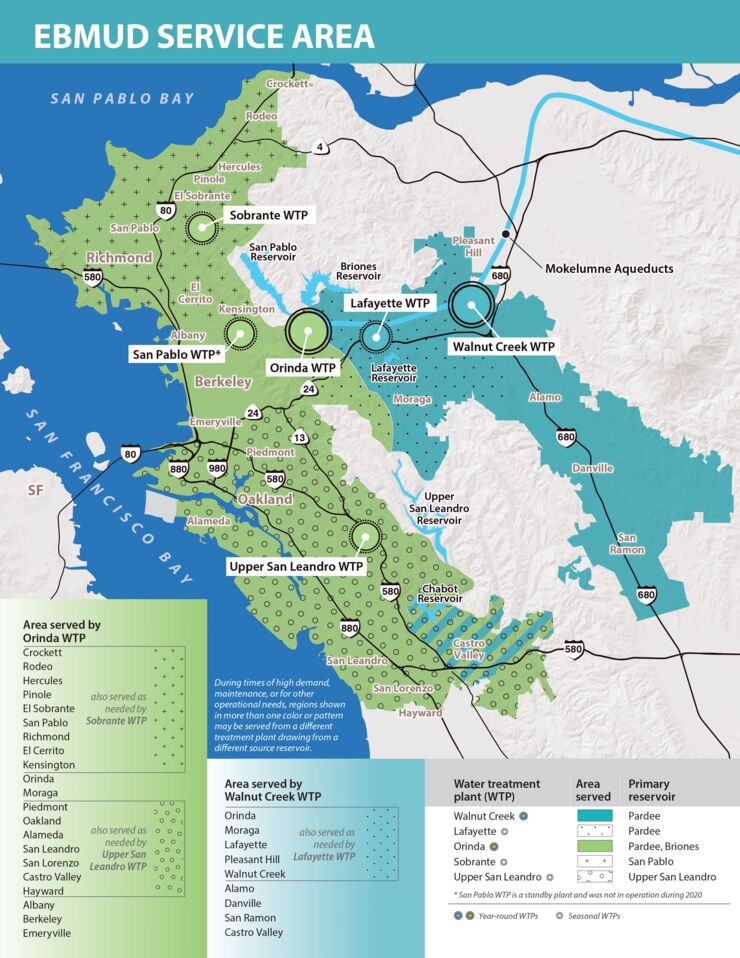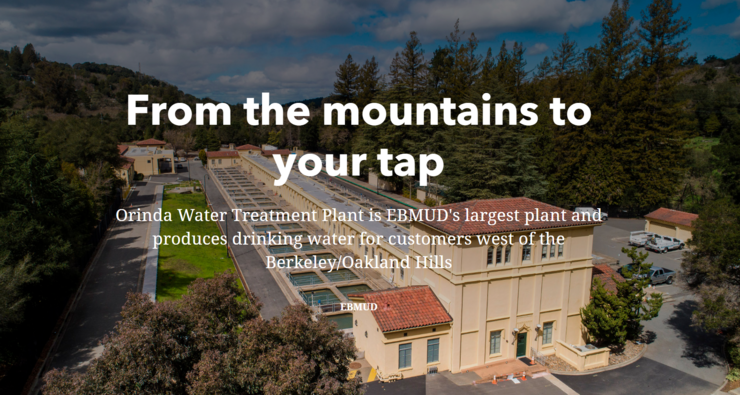EBMUD is vigilant about water quality. We work to protect our customers' water supply every step of the way by guarding the watershed lands surrounding our reservoirs, testing water as it travels many miles through aqueducts and distribution pipelines, and maintaining the best water storage and treatment.
Virtual tour of Orinda Water Treatment Plant
Walk through EBMUD's largest water treatment plant where we produce 1.84 billion glasses of drinking water every day. Must use Google Chrome or Microsoft Edge.
The Orinda Water Treatment Plant has the largest output, with a maximum capacity of 200 MGD. This plant serves all or parts of Alameda, Albany, Berkeley, El Cerrito, Emeryville, Moraga, Oakland, Orinda, Piedmont, Richmond and San Leandro. The other plants supply water in varying amounts to the balance of the EBMUD service area.
Every drop of water delivered to customers is filtered through sand and anthracite. Each water treatment plant also provides disinfection, fluoridation and corrosion control.

Aeration
Water entering the plant is sprayed into the air through nozzles, producing a fountain-like effect. Breaking the water into small drops adds oxygen and releases trapped gases that can cause objectionable tastes and odors.
Coagulation
EBMUD adds coagulants to the water, allowing very small particles to stick together, forming larger particles. These larger particles are removed in subsequent steps.
Flocculation
After coagulants are added, the water is gently mixed to cause the small particles to combine and grow large enough to settle by gravity.
Sedimentation
The water flows into sedimentation basins where the particles settle to the bottom. This step removes most of the suspended matter in the water by gravity. Water for the next step (filtration) is collected from the top of the sedimentation basins.
Filtration
Any remaining particles are trapped and removed during filtration. The almost clear water from the sedimentation basins flows into deep, concrete-walled boxes. At the bottom are filter beds made up of layers of anthracite and sand. Particles are trapped in these layers as the now-clean water flows down through the filters.
Disinfection
Chlorine is added to kill pathogens such as bacteria and viruses. Chlorine also improves the performance of the filters. Precisely controlled amounts of chlorine are added. Prior to leaving the treatment plant, ammonia is added to the chlorine to form chloramine, a more stable disinfectant, that lasts longer in the distribution system.
Ozonation
At Sobrante and Upper San Leandro water treatment plants, ozone is used for disinfection and control of taste and odor causing compounds.
Fluoridation
Before the water leaves the plant, a small amount of fluoride is added to the water to promote dental health.
Corrosion Control
EBMUD adds calcium hydroxide (lime) and sodium hydroxide (caustic) to the water to control corrosion. Using lime and caustic helps to achieve a slightly alkaline chemical balance, preventing the water from corroding distribution pipes and consumers' plumbing. This keeps substances like lead, copper, and iron from leaching out of plumbing fixtures and into the drinking water.
